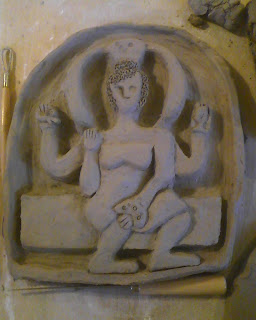After realizing just how long I had been neglecting my blog I decided perhaps it was time to come back and give it a go again. Unfortunately, after my last update I attempted to cast a mold out of my clay model, and through a series of unfortunate events the clay piece was completely destroyed and the mold was not capable for use. Trying to not let this get me down to the point of not continuing the project (nay, even the class!) was admittedly very difficult. But I digress, so let us now turn to what I /did/ do for this project.
Chapter Two: Take a mold of the clay
Simple as it sounds. This time much more simple as there were no undercuts, unseen or otherwise, to worry about. For my new object I chose a large four inch gear with 21 teeth to be used as an award for a local medieval studies group to use as awards for the 21st year of an event they were attending. The shape is easily visible in the mold here:
Chapter Three: Cast a wax positive from your mold
First, to cast a wax positive you have to get everything ready, which can take a while if you want to pretend like you're patient.
The wax must be heated up to the point of being thoroughly melted, and then brought back down to pouring temperature of ~165 F.
Additionally, any molds that will be used must soak while submerged in water until escaping air bubbles are no longer visible. In the next image you can see both my mold soaking as well as the mold for the main part of the sprue contraption.
Once you have your wax to the proper temperature, your mold prepared, and even more importantly your mold sitting somewhere level and steady, it is time to pour the wax into the mold.
After letting it cool for about twenty minutes I was able to pop it out, pour the next one, and work on refining the wax version of my gear. Originally I was attempting to do this with metal tools which left my hands and elbows aching.
I thankfully found the wax carving tools and decided to gingerly work the gears I had made into a pleasing surface texture and fix the teeth a bit as the mold degraded and produced crappy and crappy gears.
And then there were four.
Chapter Four: Sprue wax positive
Creating this contraption is an important process of creating a mold that can hold up to having molten bronze poured into it. You work upside down, creating the tube work that will allow the wax to pour out of the ceramic shell mold and the bronze to pour into the areas that you want to cast. Everything must be attached and angled in such a way that everything properly empties and fills.
Chapter Five: Use ceramic shell investment over sprued wax positive
This process was kind of gross and difficult to take pictures of during as all hands were needed on deck for this part. The ceramic shell consists of a mixture of a liquid that has the consistency and color of radioactive alien piss and a silicon based powder stuff that requires you use a mask while working with it as not to breathe in the tiny shards of evil.
With all the technelogical advances we seem to have come up with the best way to mix these two ingredients together is as follows.
- Attatch a mixing tool to an eletctric drill and stick it into the alien pee.
- Have a buddy start scooping handfulls of the silicon powder from their bucket into your bucket.
- Use the drill to stir until the whole thing is nice and thickened up.
After this is done the mixture is placed into a much larger mixer to spin around until we were ready to dip our pieces.
Chapter Six: The Bronze Pour
Once we got to site for our bronze pour we started heating up the chunks of bronze and baking our now ceramic shell incrusted wax pieces. The shell changed in color from the orange-yellow to a more cement color.
The shells were then placed into barrels surrounded with sand, the form created by the paper cup on the sprue now facing upwards to be the spout in which to pour the bronze.
Once the bronze was well above 2000 F we began suiting up and getting ready for the actual pouring process. I got the opportunity to be one of the individuals doing the pouring during the first round of pieces.
The process was exciting, and finding time for the final chapter of this project while starting the first chapter of the next should be challenging. Hurray bronze.





































